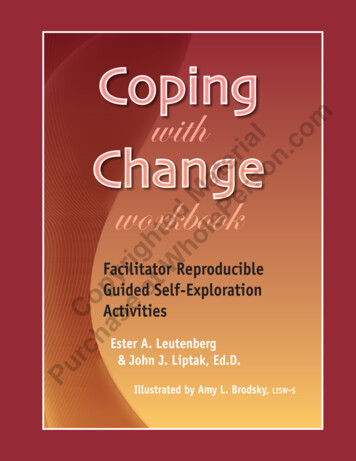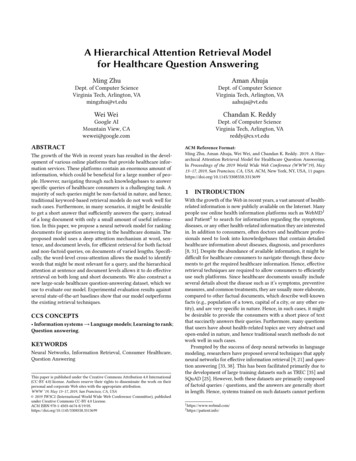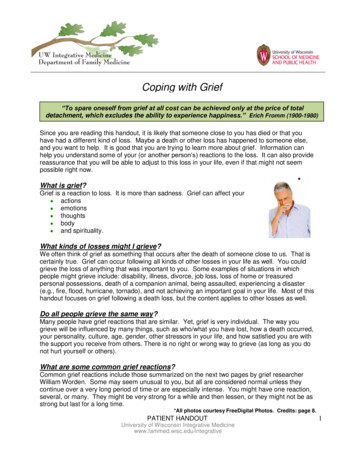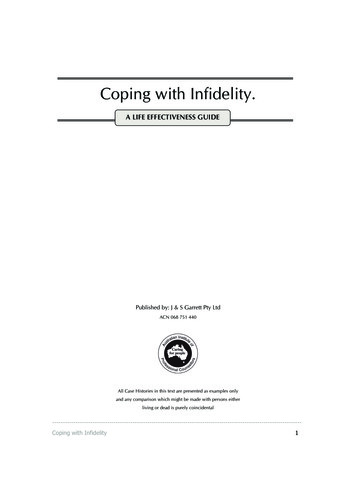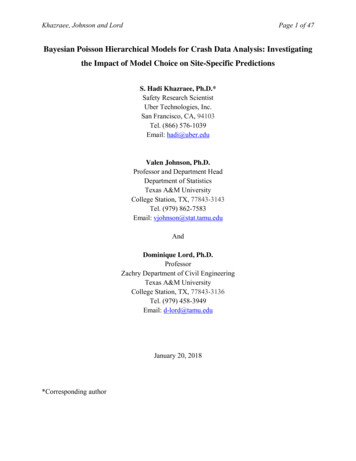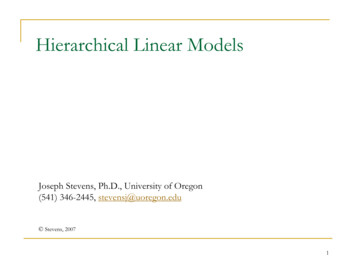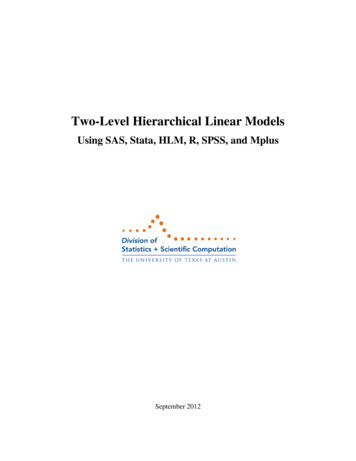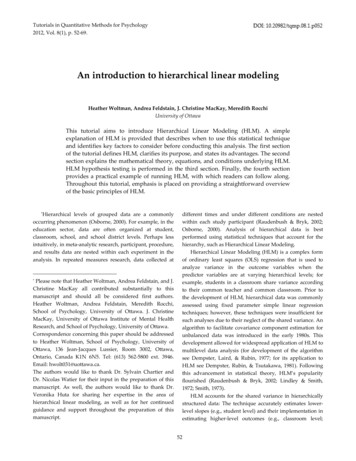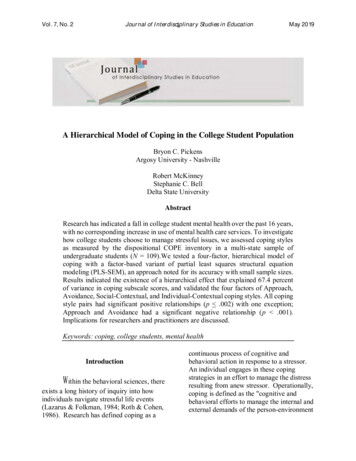
Transcription
Vol. 7, No. 2Journal of InterdisciplinaryStudies in Education1May 2019A Hierarchical Model of Coping in the College Student PopulationBryon C. PickensArgosy University - NashvilleRobert McKinneyStephanie C. BellDelta State UniversityAbstractResearch has indicated a fall in college student mental health over the past 16 years,with no corresponding increase in use of mental health care services. To investigatehow college students choose to manage stressful issues, we assessed coping stylesas measured by the dispositional COPE inventory in a multi-state sample ofundergraduate students (N 109).We tested a four-factor, hierarchical model ofcoping with a factor-based variant of partial least squares structural equationmodeling (PLS-SEM), an approach noted for its accuracy with small sample sizes.Results indicated the existence of a hierarchical effect that explained 67.4 percentof variance in coping subscale scores, and validated the four factors of Approach,Avoidance, Social-Contextual, and Individual-Contextual coping styles. All copingstyle pairs had significant positive relationships (p .002) with one exception;Approach and Avoidance had a significant negative relationship (p .001).Implications for researchers and practitioners are discussed.Keywords: coping, college students, mental healthIntroductionWithin the behavioral sciences, thereexists a long history of inquiry into howindividuals navigate stressful life events(Lazarus & Folkman, 1984; Roth & Cohen,1986). Research has defined coping as acontinuous process of cognitive andbehavioral action in response to a stressor.An individual engages in these copingstrategies in an effort to manage the distressresulting from anew stressor. Operationally,coping is defined as the "cognitive andbehavioral efforts to manage the internal andexternal demands of the person-environment
COLLEGE STUDENT COPING MODELtransaction that is appraised as taxing orexceeding the resources of the person”(Folkman, S., Lazarus, R. S., DunkelSchetter, C., DeLongis, A., & Gruen, R. J.,1986, p. 75).situation as possible. The perception of thepossibility of change leads the individual tochoose resolution specific behaviors. Theconverse is emotion-focused coping,employed when an individual does notperceive change as a possible option. Eitherof these coping forms can result in positiveor negative outcomes, and in many ways areintertwined (i.e., calming one's emotions ofanger to focus on more problem-solvingstrategies of conflict resolution). However,for the purposes of our conceptualization,this model appears to be a bettercategorization of coping type rather thancoping style. This conclusion is partiallysupported by the categorizations of theCOPE Inventory, the instrument used in thisstudy. See Figure 1 for a visual explanationof our proposed relationship between copingstyle, type, and strategies.The stress-related implications formental health are also well documentedwithin the literature, suggesting that stress isa major factor within the etiologicalunderstanding of mental illness (Hilsman &Garber, 1995; Monroe & Simons, 1991;Walker & Diforio, 1997). Coping behaviorssit squarely within this interplay of stressand wellness as mediators, with evidencesuggesting that the way individuals cope canhave a significant relationship with mentalhealth outcomes (Aldwin & Revenson,1987; Folkman, Lazarus, Gruen &DeLongis, 1986; Suldo, Shaunessy &Hardesty, 2008).The avoidance/approach model. Inthe past 30 years, the literature has produceda number of different conceptualizations forcoping. We will focus on coping asstrategies that exist on theapproach/avoidance continuum. While theapproach/avoidance perspective on copinghas been present within the literature formany years, Roth and Cohen (1986) fleshout the particulars. They imply that anunderstanding of approach and avoidancecoping as analogues for "good" and "bad" isshort sighted. A more appropriateconceptualization is one that accounts forboth the costs and benefits of each copingstyle in relation to the specificcircumstances. For example, avoidancecoping such as denial may not be effectivein the long-term, but denial in the short termmay reduce stress enough for an individualto allow normal functioning until they areable to reduce other stressors and give thisnew stressor a greater proportion ofattention.CopingThe vast majority of theories relatedto coping have evolved frompsychodynamic theory as a means of egoprotection in the face of a stressor thatpushes an individual past the point ofmanageability. Over the past 30 years, manydifferent proposed coping styles, strategies,and types have evolved, to the point wherethe sheer wealth of information isoverwhelming. However, out of this work,two major conceptualizations have garneredthe most emphasis: emotionfocused/problem focused coping andapproach/avoidance coping.The problem-focused/emotionfocused model. This particular model ofcoping, detailed by Lazarus and Folkman(1984), suggests individuals respond tostressors in one of two ways. Problemfocused coping occurs when an individualperceives movement through a stressful2
COLLEGE STUDENT COPING MODELApproach strategies lead anindividual toward a stressor with theintention for resolution. Conversely,avoidant strategies lead away from a stressorwith the intention to reduce the negativeimpact on the self. Approach strategies havelong been seen as the more adaptive of thetwo, and avoidant almost entirely nonadaptive (Moos & Holahan, 2003; Stowell,Kiecolt-Glaser, & Glaser, 2001). However,approaching a stressor can increase anxietylevels (Roth & Cohen, 1986), so it appearsneither approach coping nor avoidancecoping can be defined so narrowly.Additionally, there is support for thepositive impact of avoidance coping.Avoidance, though typically viewed as nonadaptive, has been shown to reduce stressand prevent anxiety from becomingunmanageable (Roth & Cohen, 1986), to bebeneficial when the situation is perceived asuncontrollable (Lazarus, 1983), and toprevent the use of more problematicavoidance coping such as substance use(Nielsen & Shapiro, 2009).described above, but as a part of existingcategorization rather than a distinct categoryin its own right. Despite this simplification,multiple studies of coping from both theapproach/avoidance and problem/emotionfocus models have identified a consistentthird factor regarding social copingbehaviors when assessing coping with theDispositional COPE Inventory (Carver,Scheier & Weintraub, 1989; Connor &Connor, 2003; Fortune, Richards, Griffiths& Main, 2002; Kallasmaa & Pulver, 2000;Lyne & Roger, 2000; Stowell, KiecoltGlaser & Glaser, 2001). Further work byLitman (2006) identified social coping as aseparate factor along with approach andavoidance coping. In Litman’s (2006) factoranalysis, the COPE subscales of EmotionalSocial Support, Instrumental Social Support,and Focus On and Venting of Emotions allloaded on to a single factor, which theytermed social-approach.Obviously, coping can beconceptualized in a myriad of ways.However, the college experience presentsnew, unprecedented stressors for students nomatter the frame of reference. The waystudents cope have a profound impact onvarious aspects of their lives, includingmental health.This conceptualization of approachand avoidance coping places a strongemphasis on the context of the situation.When studying a college population, theemphasis on context translates to the need tofully understand the unique stressors facedby college students (Ross, Niebling, &Heckert, 1999). Such an understandingrequires an awareness of the sources ofstress, implications for wellness, andknowledge of how research hasconceptualized coping within thispopulation.Stress and the College Student PopulationCollege student mental health. Theability of students to manage their collegeexperience is a chief concern for highereducation institutions. Studies indicate adramatic rise in both the prevalence andseverity of mental health concerns forcollege students over the last 16 years, andcollege counseling centers have reported anincrease in students seeking services(Benton, Robertson, Tseng, Newton, &Benton, 2003; Gallagher, 2014; Gallagher,Gill, & Sysco, 2000). Roberts, Warner,The concept of social coping mustalso be emphasized in this discussion.Characterized by seeking support fromothers to manage a stressor, social copingbehaviors have often been conceptualizedwithin the more traditional models of coping3
COLLEGE STUDENT COPING MODELLyketsos, Frank, Ganzini, and Carter (2001)found that 47 percent of students surveyedreported at least one mental health problem.Depression, anxiety, and psychotic disordersare some of the most prominent issuespresented by college students (Collins &Mowbray, 2005; Megivern, Pellerito, &Mowbray, 2003). Furthermore, there isevidence to suggest coping behavior has adirect impact on mental wellness and thedevelopment of mental illness (Aldwin &Revenson, 1987; Folkman, Lazarus, Gruen,& DeLongis, 1986). Avoidance-basedcoping in students has been found to be aprime predictor of mental health issues suchas depression (Dyson & Renk, 2006;Mahmoud, Staten, Hall, & Lennie, 2012).Additionally, research suggests coping to bea mediator for mental health outcomes inlate adolescence/early adulthood (Suldo,Shaunessy, & Hardesty, 2008).Brown, Evans, Patterson, Petersen, Doll,Balding, & Regis, 2000). Additionally,evidence suggests that adolescents andyoung adults are more likely to engage inmaladaptive coping strategies compared toother age groups (Blanchard-Fields, Sulsky,& Robinson-Whelen, 1991; Irion &Blanchard-Fields, 1987). More specifically,both college men and women have beenfound to use more avoidance oriented,maladaptive coping strategies to manageevery day stressors when compared to otherage groups. However, among collegestudents specifically, women seem morelikely to engage in approach strategies thancollege men, especially emotion-focusedstrategies. Dyson and Renk (2006) foundsimilar results, citing femininity as apredictor of emotion focused coping andfinding neither femininity nor masculinity abetter predictor for problem-focused copingthan the other. Despite this, approachcoping overall has been linked to less stressand fewer symptoms of illness (Blake &Vandiver, 1988; Soderstrom, Dolbier,Leiferman & Steinhardt, 2000), and seekingsocial support, engaging in problem-solving,and cognitively restructuring situations canlead to more positive outcomes within theage group (Herman-Stabl, Stemmler, &Petersen, 1995; Mahmoud, Staten, Hall, &Lennie, 2012). This evidence suggests valuefor the development of coping interventionswith college students once a more thoroughunderstanding of college student copingbehavior can be established.In addition to the general impact onwell-being, mental health issues in collegestudents can negatively impact academicreadiness and success. Students combattingmental health issues struggle with poorgrades, academic probation (Megivern,Pellerito & Mowbray, 2003), decreasedpersistence to graduation (Pritchard &Wilson, 2003), and poor class attendance(Collins & Mowbray, 2005). Evidencesupports a greater focus on college studentmental health is justified from both studenthealth and institutional health perspectives.Coping behavior in the college-ageindividual. This leads to the question: whenfaced with increasingly stressful situations,what strategies do college students use tocope? Unfortunately, research suggestscollege students aren't using the resourcesavailable to them in the form of collegecounseling centers, with as many as 90percent of students failing to seek assistancefrom campus-based support (Stewart-The Dispositional COPE InventoryCarver, Scheier, and Weintraub(1989) developed the Dispositional COPEwith the purpose of providing acomprehensive assessment tool to measurecoping behavior. Their impetus to create theCOPE was based on what they perceived tobe three problems with existing measures.4
COLLEGE STUDENT COPING MODEL1. Pre-existing measures did notsample all the specific domains theyfelt were of interest in the study ofcoping behavior.2. Coping scales developedpreviously often lacked a clear focusin assessment items.3. Earlier assessments wereestablished empirically rather thantheoretically and were often poorlylinked to established theoreticalconcepts.between approach and avoidance copingmakes more theoretical sense and suggeststhe use of different forms of structuralequation modeling may be more appropriateto provide insight into coping's complex,interdependent structure. The cause of thisdiscrepancy is not immediately clear;Soderstrom et al. (2000) did not examine ordiscuss possible reasons, and none of theother variables in their analysis have beenshown to have such an effect. While it is notour central focus, we will attempt to shedsome light on this issue in our analysis.There has been extensive evaluationof the information garnered from the COPEInventory. Litman (2006) worked ondetermining the dimensionality of the COPEInventory within the framework ofapproach/avoidance coping styles. Hisstudy suggests that items on the COPE fallinto two approach categories (self-sufficientand socially supported coping) and oneavoidance category. However, like theshortcomings of previous coping measureslisted in Carver, Scheirer and Weintraub(1989), these categories were establishedempirically rather than theoretically. Thenature of the validation of the categorieswithin Litman (2006) does not imply a lackof relevance but simply leaves room forfurther investigations from a moretheoretical perspective.MethodologyTheoryWhile previous research frequentlydivided coping behaviors into anapproach/avoidance dichotomy, not allcoping instruments are designed to measuresuch a structure. This means that at timessubscales are assigned to categories where itis conceptually difficult to justify theirplacement. For instance, Litman (2006)divided subscales of the COPE inventoryinto self-sufficient approach, socialapproach, and avoidance. Their analysisplaced the subscales Restraint and Humorboth in approach style coping, despite thefact that both types may be used either toapproach or to avoid problematic issues.Both subscales consistently had lowloadings on approach style coping, with anaverage of .55 for restraint and .40 forhumor across two models. Based on thisevidence, we hypothesized the existence of afourth coping style: individual-contextualcoping, which contains topics an individualmay use to approach or avoid a stressfulissue. For example, humor may be usedeither to enable an individual to deal with astressful event or distance themselves fromthe event, preventing the individual fromprocessing the stressor.When judging by bivariatecorrelations, approach and avoidant copingstrategies often display a positiverelationship or no relationship at all (Carter,Scheirer, & Weintraub, 1989; Litman,2006). However, when modeled via pathanalysis, the correlation between approachand avoidance coping becomes negative(Soderstrom, Dolbier, Leiferman, &Steinhardt, 2000), suggesting that asapproach coping increases, avoidancecoping decreases and vice versa. Thisconceptualization of the relationship5
COLLEGE STUDENT COPING MODELOur approach further differs fromprevious work in that we do not considersocial coping to be a category of approach.The social scales on the COPE, such asFocus on Emotions (“I get upset and amreally aware of it”), do not generally implythat an individual is moving towards oraway from a topic. While this too has notbeen fully tested on a theoretically-basedmeasure such as the COPE, research onempirically-based instruments has shown apositive relationship between seeking socialsupport and avoidance coping (Dumont &Provost, 1999). The social coping style thusbears some similarity to the individualcontextual style. However, one may practiceindividual-contextual coping strategiesalone, whereas social coping generallyrequires the presence of others. Sociallyfocused personality traits such asextraversion may thus have a larger impacton social coping than on individualcontextual. As such, we consider the socialand individual aspects of contextual copingto be conceptually related but not identical,and refer to them as social-contextual andindividual-contextual. Empirical support forthis position exists as well; Litman (2006)found in two exploratory factor analyses ofCOPE data that the subscalesassigned to social-contextual copingconsistently loaded on a separate factor fromthe subscales we consider individualcontextual coping.Because coping strategies fit withincoping types, which fit within coping styles,we further hypothesized a hierarchicalrelationship between coping strategies,types, and styles, as covered in Figure 1. Toour knowledge, this is the first time ahierarchical, four-factor model of coping hasbeen examined. While researchers have notyet tested the COPE inventory forhierarchical structure, they have shown thatdata from other coping assessments areclearly multilevel (Tobin, Holroyd,Reynolds, & Wigal, 1989; Iwasaki &Mannell, 2000).Hypotheses and Research QuestionsThis theory leads us to three researchquestions:1) What, if any, is the nature of therelationship between individualcontextual coping and other copingstyles?2) What, if any, is the nature of therelationship between socialcontextual coping and other copingstyles?3) What, if any, is the nature of therelationship between approach andavoidance coping?Along with these questions are the followinghypotheses:1) There will be significant positiverelationships between individualcontextual coping and all othercoping styles.2) There will be significant positiverelationships between social-Figure 1.Hypothesized hierarchical structureof coping.6
COLLEGE STUDENT COPING MODELcontextual coping and all othercoping styles.3) There will be a significant negativerelationship between approach andavoidance coping.gender non-dichotomously. Participantswere recruited from undergraduatepsychology courses at a small southernuniversity and through postings on variouslistservs targeted at students and studentaffairs professionals. All participants wereenrolled in a drawing to receive a 25Amazon gift card upon successfulcompletion of the study.InstrumentsCoping skills were measured withthe dispositional COPE inventory (Carver,Scheier, & Weintraub, 1989), chosen for itswide variety of coping behaviors measured.The COPE inventory assesses the frequencyof specific coping strategies (such as “I letmy feelings out,” or “I make jokes aboutit”). Participants respond to each item on ascale of one (“I usually don’t do this at all”)to four (“I usually do this a lot”). Copingbehaviors are divided up into 15 subscalesof four items each, with each subscalemeasuring a different type of copingbehavior (such as “Humor” or “Denial”).After removing 20 results for noncompletion, the final N was 109.Participants identified their gender as 35percent male, 62 percent female, 1 percentnon-dichotomous. Participant ethnicity was14.7 percent African American, 70.6 percentCaucasian, 7.3 percent Hispanic or Latino,3.7 percent Native American, and 3.7percent Asian/Pacific Islander. It wasdetermined through an analysis withG*Power 3.1 (Faul, Erdfelder, Buchner, &Lang, 2009) that sample sizes were notsufficient to meaningfully test fordifferences by gender or ethnicity across the15 COPE subscales.Carver, Scheier, and Weintraub(1989) found the COPE to have acceptablereliability, with an average Cronbach’s alphaof .71 across all subscales. Theyadditionally provided evidence for theCOPE’s convergent and discriminantvalidity based on subscale correlations withconceptually similar personality traits. Forexample, the subscale PositiveReinterpretation and Growth was positivelycorrelated with the personality trait ofoptimism (r .41) and negatively correlatedwith anxiety (r -.25).AnalysisMain model. We grouped subscalesinto four copin
Argosy University - Nashville Robert McKinney Stephanie C. Bell Delta State University Abstract Research has indicated a fall in college student mental health over the past 16 years, with no corresponding increase in use of mental health care services. To investigate how college students cho


